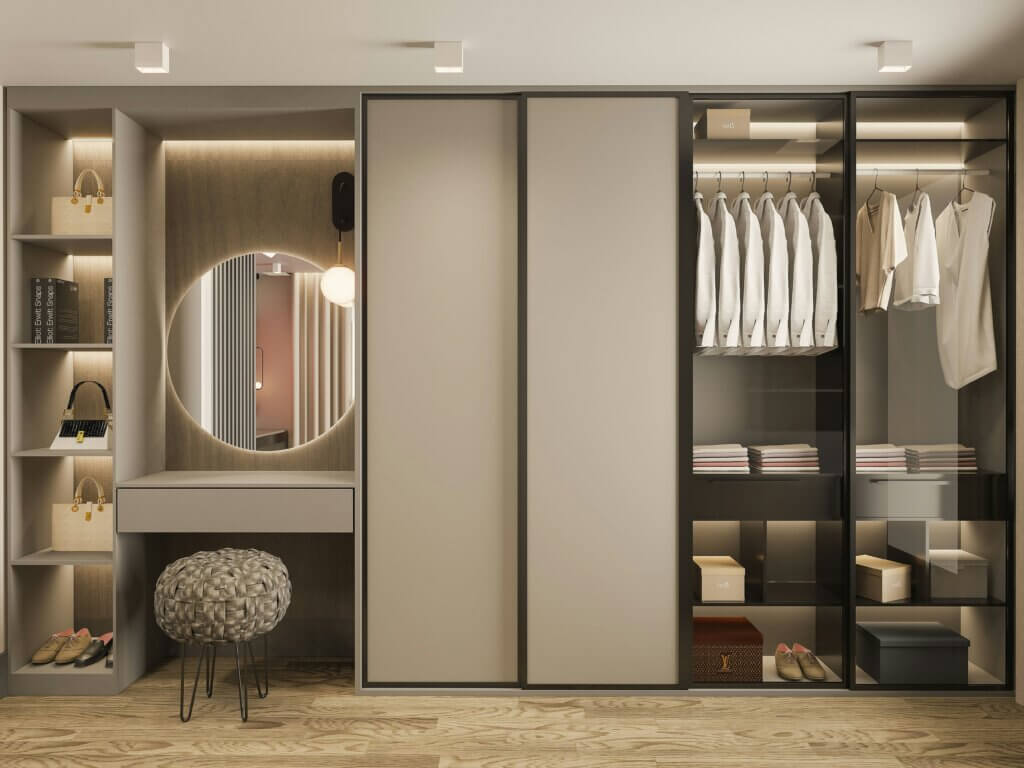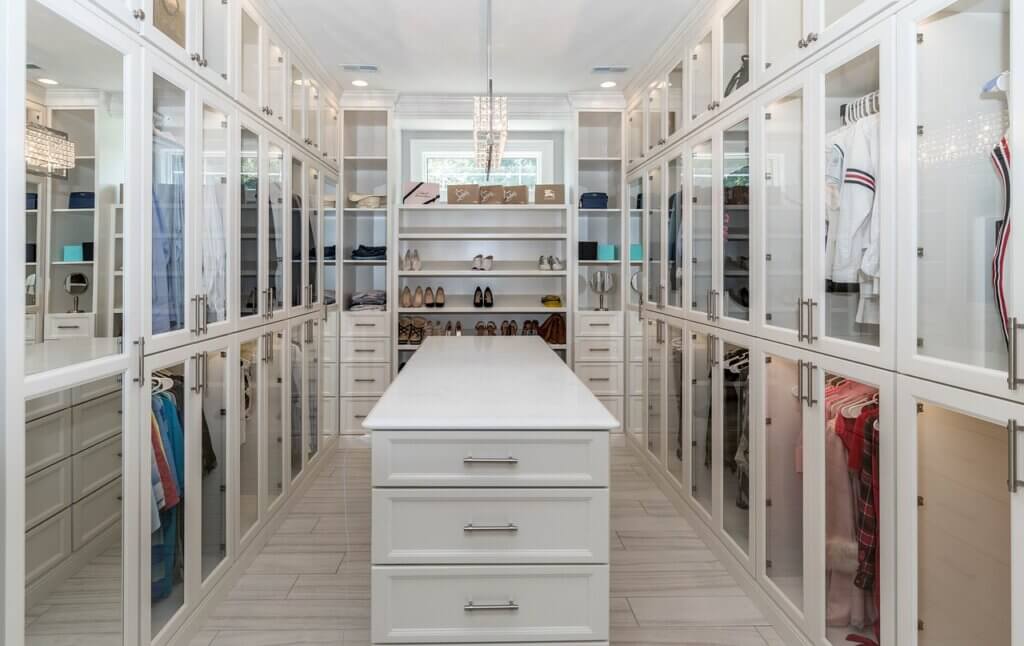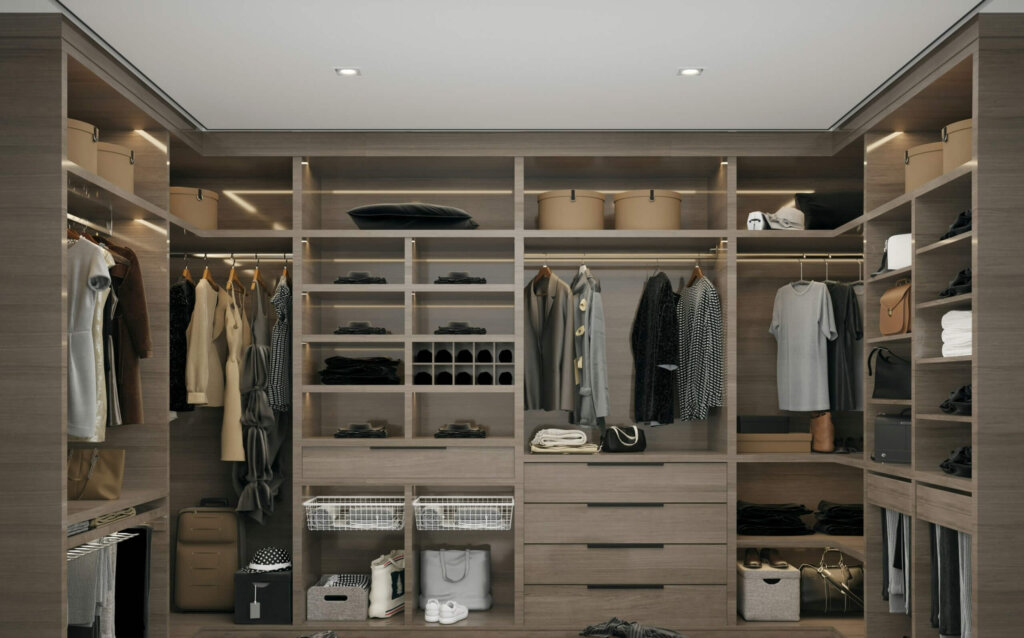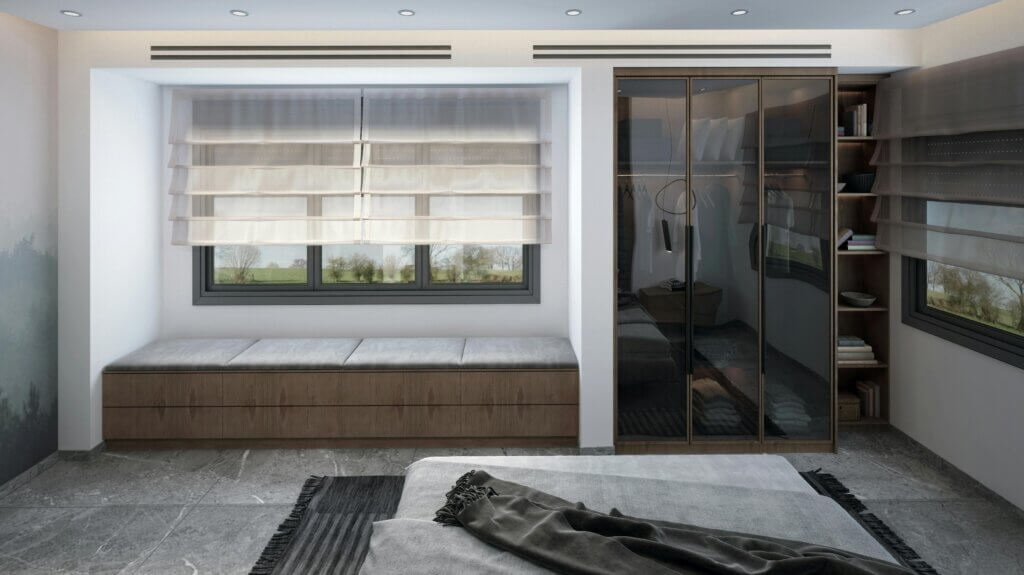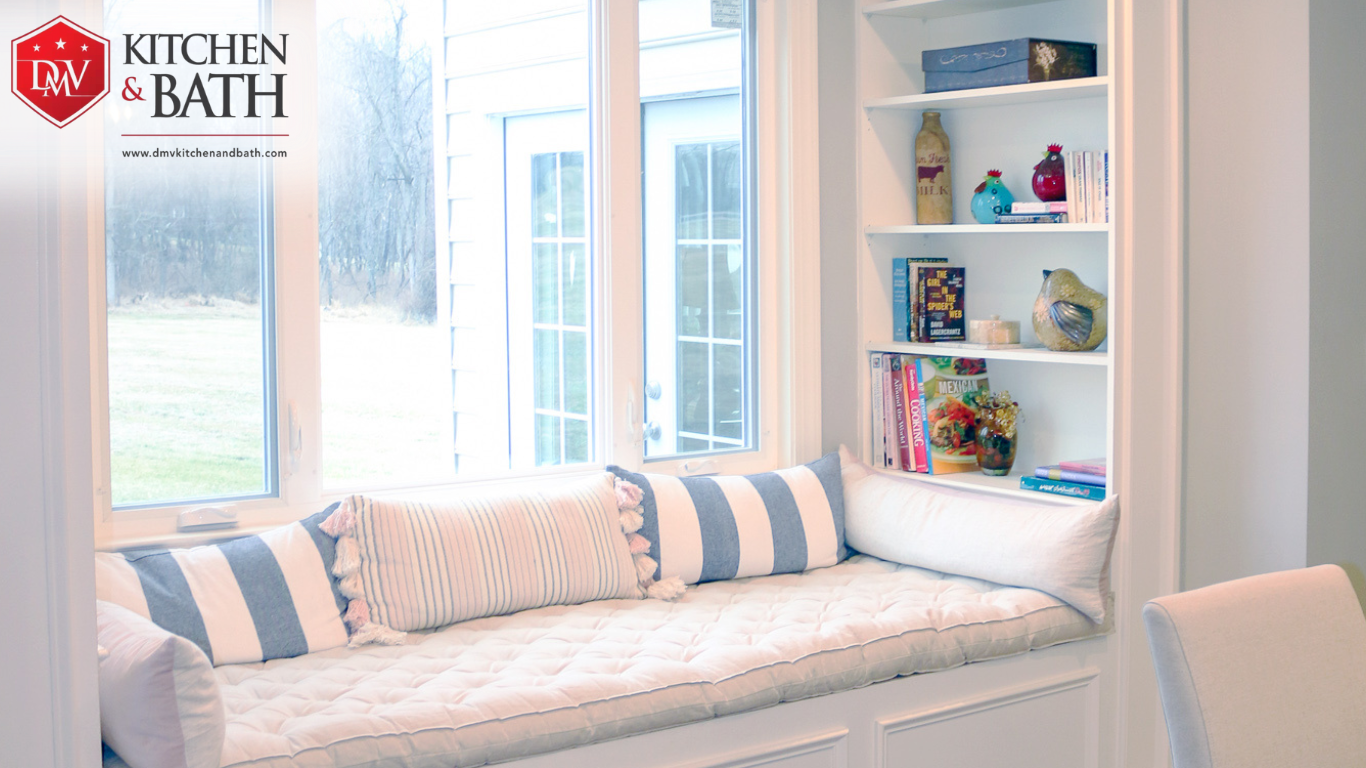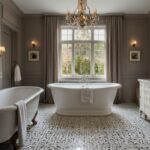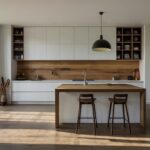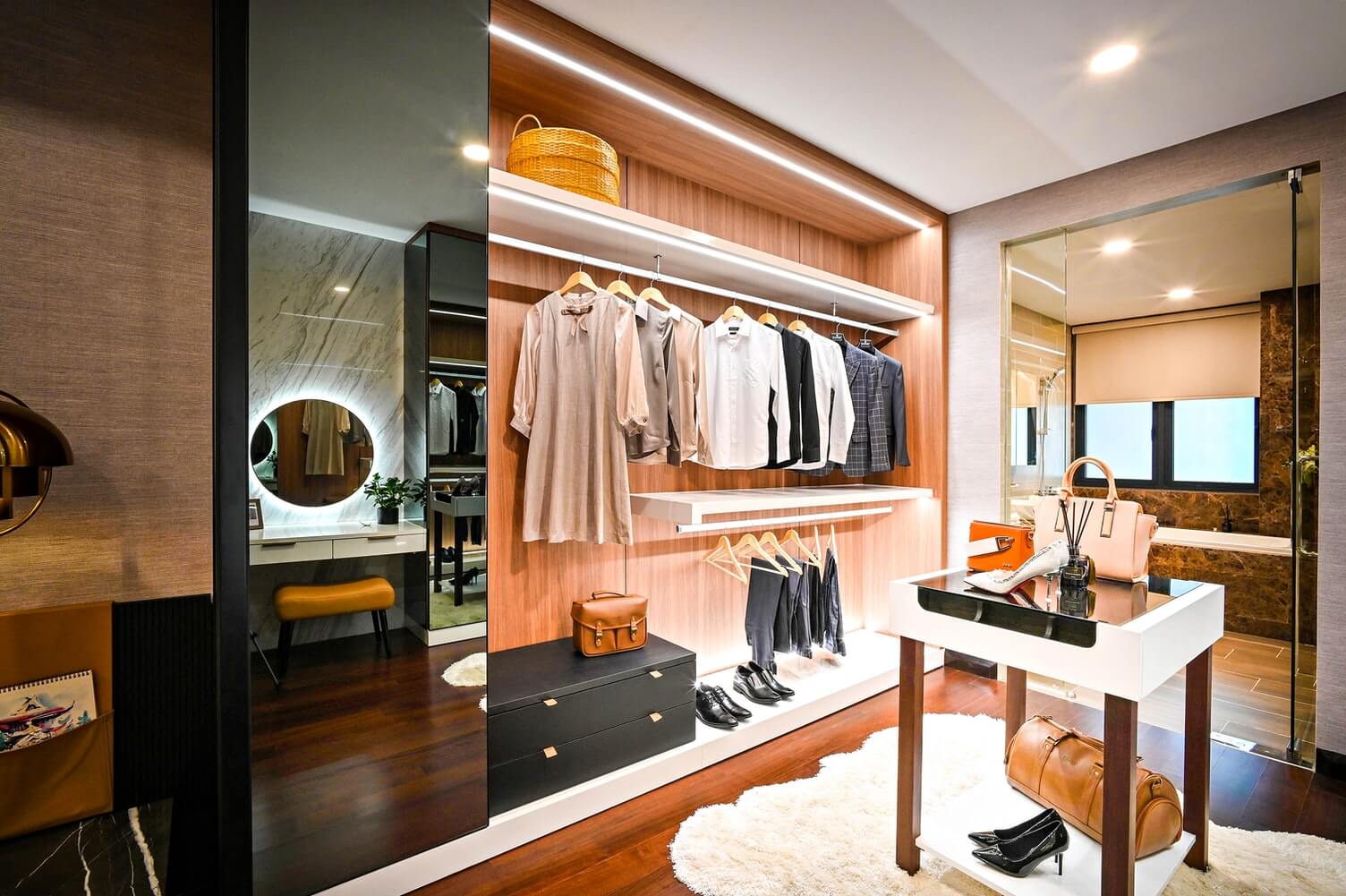
2024 Closet Design Trends to Inspire Your Next Renovation15 min read
Let’s talk about closet design. This area of home organization and decor has come a long way from its humble beginnings as a mere storage space for clothes. Designing a closet is much more than just creating a space to store your clothes and accessories. It’s about crafting an area that reflects your style, meets your practical needs, and adds to the overall aesthetics of your home.
When you think about closet design, the first thing that often comes to mind is space optimization. But beyond just maximizing space, modern closet design focuses on personalization and efficiency. Each person’s wardrobe is unique, filled with items that hold personal value and represent individual tastes. Therefore, a well-designed closet should cater to your specific needs, whether you have a penchant for shoes, an extensive collection of handbags, or a variety of seasonal clothing.
As we delve into 2024, the trends in closet design are more exciting and innovative than ever before.
Contents
The Basics Of Closet Design
Let’s take a journey into the fascinating world of closet design, where functionality meets creativity, and where every detail counts in transforming an ordinary space into a sanctuary of organization and beauty. Let’s start with the basics.
Layout
The layout of your closet is the foundation of the design. It needs to facilitate easy access and visibility for all your items. Imagine stepping into your closet and immediately seeing everything you need without having to sift through clutter. This is where strategic planning comes into play.
By incorporating features like double hanging rods, adjustable shelves and shelving, and pull-out drawers, you can create a flexible space that adapts to your evolving wardrobe.
Lighting
Lighting is another crucial element that can dramatically enhance the functionality and ambiance of your closet. Proper lighting not only helps you see your clothes better but also creates a luxurious feel.
From LED strip lights under shelves to elegant chandeliers, the options are endless. Good lighting elements can transform a simple closet into a boutique-like space where you enjoy spending time.
Materials and Finishes
The choice of materials can significantly impact the look and feel of your closet. High-quality wood, glass, and metal finishes not only add durability but also elevate the overall aesthetic.
Imagine sleek glass doors that showcase your shoe collection or a rich walnut finish that adds a touch of sophistication. These materials can be tailored to match the rest of your home’s decor, creating a seamless transition between your closet and other living spaces.
Customization
Customization is key when it comes to closet design. Consider incorporating personalized elements such as built-in jewelry organizers, tie racks, or a vanity area. These custom features can make your closet not only functional but also uniquely yours. For those with a passion for fashion, a dedicated space for displaying favorite pieces can turn your closet into a mini showroom.
Sustainable Design
In addition to aesthetic and functional considerations, sustainable design is becoming increasingly important. Using eco-friendly materials and practices not only helps the environment but also ensures that your closet is a healthy space. Look for sustainably sourced wood, low-VOC finishes, and energy-efficient lighting options to create a green closet that aligns with your values.
2024 Closet Design Trends
The world of closet design is evolving rapidly, reflecting broader trends in home decor, technology, and sustainability. As we move into 2024, the latest closet design trends emphasize a fusion of functionality and style, aiming to create spaces that are both beautiful and efficient.
Embracing Smart Technology
One of the most exciting developments in closet design is the integration of smart technology. Incorporating smart technology into closet design is a game-changer. Imagine walking into your closet and having the lights turn on automatically, adjusting to the perfect brightness based on the time of day.
Here’s how smart technology is making its mark.
Automated Lighting
One of the most practical applications of smart technology in closets is automated lighting. Motion sensors can detect when you enter the closet, automatically turning on the lights and adjusting their brightness based on the time of day or your preferences.
This ensures optimal visibility while saving energy by only operating when needed. Some advanced systems also allow you to control the lighting via a smartphone app, offering customization and convenience at your fingertips.
Smart Mirrors
Smart mirrors are becoming a staple in modern closet design. These mirrors come equipped with built-in displays that can show you the weather forecast, your daily schedule, or even virtual wardrobe suggestions based on the clothes you have. Some smart mirrors also have integrated lighting that adjusts to mimic different environments, helping you choose the perfect outfit for any occasion.
Climate Control
Maintaining the right environment for your clothes is crucial, especially for items made from delicate fabrics. Smart climate control systems can monitor and adjust the temperature and humidity levels in your closet to keep your clothes in optimal condition.
These systems can be programmed to different settings depending on the season or specific needs of your wardrobe, protecting your garments from damage caused by excessive moisture or dryness.
Voice Control and Integration
Voice-activated systems, such as those powered by Amazon Alexa or Google Assistant, are making their way into closet designs. These systems allow you to control various aspects of your closet, such as lighting, music, and climate, using simple voice commands. Integration with other smart home devices creates a seamless experience, enhancing the overall functionality of your living space.
Sustainable Choices
Sustainability is at the forefront of many design decisions in 2024. Homeowners are increasingly aware of the environmental impact of their choices and are opting for eco-friendly and stylish materials. Here are some of the key sustainable materials being used in closet design for 2024.
Reclaimed and Recycled Wood
Reclaimed wood is a popular choice for sustainable closet design. This material is sourced from old buildings, barns, and other structures, giving it a unique, rustic appearance. Using reclaimed wood not only reduces the demand for new lumber but also keeps valuable materials out of landfills.
Bamboo
Bamboo is another sustainable material that is gaining popularity in closet design. It grows much faster than traditional hardwoods, making it a highly renewable resource. Bamboo is also incredibly strong and durable, making it an excellent choice for shelves, drawers, and other closet components. Its natural aesthetic adds a touch of elegance and warmth to any space.
Recycled Metal
Metal components, such as handles, rods, and shelving supports, can be made from recycled steel or aluminum. These materials are durable and have a lower environmental impact compared to new metal production. Recycled metal can be finished in various ways to complement the overall design of the closet.
Eco-friendly Finishes
The finishes used on closet materials can also contribute to sustainability. Eco-friendly paints and stains that are low in volatile organic compounds (VOCs) are better for indoor air quality and reduce the emission of harmful chemicals. These finishes are available in a wide range of colors and styles, ensuring that sustainability doesn’t mean compromising on aesthetics.
Recycled Plastic
Some used closet storage systems incorporate recycled plastic for components like drawer dividers, bins, and shelving supports. Recycled plastic is versatile and durable, providing a practical solution for organizing smaller items. Using recycled plastic helps reduce waste and supports the recycling industry.
Versatile and Modular Designs
Flexibility is key in modern closet design. Versatile modular systems allow you to adjust shelving, rods, and storage components to suit your changing needs. This adaptability is especially useful in multi-purpose spaces where a closet might also serve as a home office or a workout area.
Flexibility and Customization
One of the key benefits of modular closet systems is their flexibility. These systems consist of interchangeable components such as shelves, drawers, hanging rods, and baskets that can be rearranged to suit your changing needs.
This customization allows you to tailor your closet to your specific preferences, whether you need more hanging space for clothes, additional hanging space on shelves for shoes, or drawers for accessories.
Adaptability for Different Spaces
Modular designs are particularly useful in various types of living spaces, from small apartments to large homes. They can be easily adapted to fit walk-in closets, reach-in closets, or even unconventional spaces like under-stair storage or attic eaves.
This adaptability ensures that you can make the most of every inch of available space, regardless of the size or layout of your home.
Multi-Functional Spaces
In today’s homes, space is often at a premium, and many homeowners are looking for ways to make their closets serve multiple functions. Modular closet systems can be designed to double as home offices, crafting stations, or even small fitness areas.
By incorporating features like fold-down desks, hidden workstations, or built-in exercise equipment, these versatile designs make it possible to create a multifunctional space that meets various needs.
Ease of Installation and Reconfiguration
Another advantage of modular closet systems is the ease of installation and reconfiguration. Many modular components are designed for easy assembly and can be installed without professional help.
This makes it simple to reconfigure your closet layout as your needs change, whether adding new pieces, rearranging existing ones, or moving to a full closet renovation or new home. The ability to modify your closet system without significant effort or expense is a major draw for many homeowners.
Open Shelving and Display
Open shelving continues to be a popular trend, providing both accessibility and aesthetic appeal. Displaying items like shoes, handbags, and accessories on open shelves not only makes them easy to reach but also turns them into decorative elements.
Glass Shelves
Glass shelves add a touch of elegance and sophistication to open shelving designs. They are also practical, as they don’t obstruct light, making your closet feel brighter and more spacious. Glass shelves are easy to clean and maintain, providing a sleek, modern look that complements various design styles.
LED Lighting
Integrated LED lighting can highlight specific areas of your open shelving, creating a dramatic effect and making it easier to see your items. LED strips can be placed under shelves, along the edges, or behind items to add depth and dimension. This lighting not only enhances visibility but also adds a luxurious feel to your closet.
Decorative Elements
Incorporating decorative elements such as mirrored back panels, textured finishes, or metallic accents can elevate the design of open shelving. These features add a touch of personality and can be tailored to match the overall aesthetic of your home. Decorative brackets and supports can also add visual interest while providing sturdy support for the shelves.
Integrated Seating
Integrated seating is a rising trend in closet design for 2024, offering a blend of comfort, luxury, and practicality. Incorporating seating into your closet space not only enhances its functionality but also adds an element of sophistication and convenience. Here’s a deeper dive into the features of integrated seating in modern closets.
Built-In Benches
Built-in benches are a popular choice for integrated seating in closets. These can be designed to fit seamlessly into the overall layout, often positioned under a window or along a wall.
Benches with storage compartments underneath offer the dual benefits of seating and additional space for organizing items. Upholstered benches add a touch of elegance and comfort, making the closet feel more like a personalized retreat.
Seating Nooks
Creating a seating nook within a closet can add a cozy, intimate feel. Nooks can be designed with cushioned seats, pillows, and even small side tables for added convenience.
This setup is perfect for those who spend time planning outfits or enjoying a quiet moment in their closet. Adding built-in lighting and shelving around the nook can enhance its functionality and aesthetic appeal.
Versatile Furniture
For those who prefer a less permanent solution, versatile furniture pieces such as ottomans, stools, or accent chairs can be used as seating in the closet. These pieces can be easily moved or reconfigured as needed, offering flexibility. Choosing furniture that complements the closet’s design ensures that the space remains cohesive and stylish.
Minimalist Aesthetics
Minimalist aesthetics in closet design have gained significant traction in recent years, and in 2024, this trend will continue to thrive. Emphasizing simplicity, functionality, and a clutter-free environment, minimalist closet designs aim to create serene and organized spaces that reflect a clean and modern lifestyle. Here’s an in-depth look at the features of minimalist closet design.
Neutral Color Palette
A neutral color palette, consisting of whites, grays, and beiges, is a hallmark of minimalist design. These colors create a sense of spaciousness and tranquility. Occasionally, muted tones like soft blues or greens may be incorporated to add subtle variation without overwhelming the simplicity of the space.
Hidden Storage
To maintain a clean and uncluttered look, minimalist closets often incorporate hidden storage solutions. This can include concealed drawers, pull-out shelves, and integrated laundry hampers. By keeping items out of sight, these features contribute to the closet organization’s overall sense of order and simplicity.
High-Quality Materials
Minimalist design emphasizes quality over quantity. This is reflected in the use of high-quality materials that are both durable and aesthetically pleasing. Natural materials like wood, stone, and metal are commonly used, often in their simplest and most unadorned forms. The focus is on the inherent beauty of the materials rather than elaborate decorations.
Efficient Lighting
Proper lighting is crucial in a minimalist closet. LED lights are a popular choice for their energy efficiency and ability to provide bright, even illumination. Integrated lighting solutions, such as under-shelf lights or recessed ceiling fixtures, help maintain the minimalist aesthetic by avoiding bulky or overly decorative light fixtures.
Color and Texture
In 2024, closet design trends may continue to evolve, incorporating new ideas and technologies while also drawing inspiration from timeless elements like color and texture. Here’s how color and texture might be integrated into closet design trends.
Bold Color Accents
While neutral tones like white, gray, and beige may remain popular for closet interiors, there could be a trend toward adding bold pops of color. This might include vibrant accent walls, colorful shelving units, or statement-making doors. Incorporating color can add personality and energy to a closet space, making it more visually appealing.
Natural and Organic Textures
Embracing natural and organic textures can create a sense of warmth and coziness in a closet. Materials like wood, rattan, bamboo, and natural fibers might be used for shelving, storage bins, or even flooring. These textures can evoke a connection to nature and promote a sense of tranquility within the closet environment.
Luxurious Fabrics
Incorporating luxurious fabrics into closet design can elevate the space and add a touch of elegance. Velvet-covered hangers, satin-lined drawers, or plush seating upholstered in rich fabrics could be popular choices. These textures not only enhance the tactile experience but also create a sense of luxury and indulgence.
Textured Wall Treatments
Textured wall treatments, such as textured wallpaper or textured paint finishes, can add visual interest and depth to a closet space. Whether it’s a subtle texture for a sophisticated look or a more pronounced texture for a bold statement, this trend can add dimension to the walls and enhance the overall design aesthetic.
Metallic Accents
Incorporating metallic accents, such as brass or copper hardware, can add a touch of glamour to closet design. Whether it is walk-in closet drawer pulls, handles, or light fixtures, metallic elements can create visual contrast and sophistication within the space. Additionally, metallic finishes can reflect light and create an illusion of spaciousness in smaller closets.
Moving Forward
Designing a closet is about creating a space that brings joy and simplicity to your daily routine. It’s a place where organization meets style, and where you start and end your day with ease. Whether you have a small reach-in closet or a spacious walk-in, the principles of good design can transform it into a sanctuary of order and elegance.
So, as you embark on your closet design journey, think about what inspires you, what makes your daily routine smoother, and how you can infuse a bit of luxury into your everyday life. With thoughtful planning and a touch of creativity, your closet can become a personal retreat that perfectly complements your lifestyle.
Step into the future of closet design with our 2024 trends!
Elevate your space with bold color accents, embrace the allure of natural textures, and indulge in luxurious fabrics. Discover how to transform your closet into a haven of style and functionality. Contact us to schedule an appointment or visit one of our showrooms to speak with our experts.





